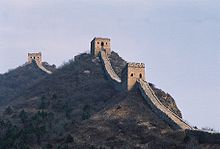Simatai
Simatai ( Chinese 司馬臺 / 司马台 , Pinyin Sīmǎtái ), a section of the Great Wall of China in the north of Miyun County , 120 km northeast of Beijing , guards the entrance to Gubeikou , a strategic pass in the eastern part of the Great Wall. Originally during the Northern Qi Dynasty (550-577) and rebuilt under Qi Jiguang in the Hongwu ( Ming Dynasty ) years , this section is one of those that preserved the original features of the Ming temporal wall. Simatai fell under the administrative area of the Ji Garrison .
The Simatai Great Wall is 5.4 km long and has 35 signal towers. Built in what appears to be a tricky location on the ridge of the Yan Shan , the section attracts attention with its steep passages. It is separated into an eastern and a western part by a valley in which there is a reservoir. The western part appears gentle and 20 well-preserved watchtowers line the wall. The eastern part is much steeper and follows the rough terrain on the edge of rock walls and over rugged peaks. The 15 watchtowers in this section are relatively narrow and offer impressive views.
The “Peking View Tower” ( Wangjinglou ), the “Angel Tower” ( Xiannulou ), the “Heavenly Ladder” and the “Heavenly Bridge”, which are not accessible for safety reasons, are to be emphasized . The "Heavenly Ladder" climbs up a slope of up to 80 ° and is the access to the Wangjinglou and Xiannulou towers, its narrowest point at the top of the wall is barely half a meter wide. Wangjinglou lies at an altitude of 986 m and is the summit of the Simatai section. Stones in this section are stamped, on which the date and the name of the construction team are noted. In good weather conditions, the lights of Beijing should be visible from here at a distance of 120 km. The 100 m long sky bridge connects Wangjinglou with Xiannulou, it is only 40 centimeters wide in places. Xiannulou has a sculpture of two lotus blossoms above the arched towers and is known for its architecture.
A monocable gondola lift allows the ascent up to part of the total height, from where a serpentine path leads to tower no. In order to be able to conquer this incline more comfortably, a cable-bound, narrow-gauge mini train was set up , starting next to the cable car mountain station, which brings tourists in the fall line of the slope to below the mountain ridge .
A popular hike is the trail from Jinshanling to Simatai on the wall.
The Beijing Municipal Cultural Relics Bureau selected the Simatai section as the top priority project for 2004. Simatai has more signal towers than other sections of the Great Wall. Using traditional building materials and methods, partially collapsed gates, battlements and wall sections were restored and reinforced.
After three years of closure, Simatai has been open to the public again as a "trial operation" since January 1, 2014. The official opening took place on October 1st, 2014.
gallery
Simatai East, view from the south over the Mandarin Duck Lake ( Simatai Reservoir ) to the respective towers No. 1 (1997).
Web links
- Fortifications - Great Wall Passages: The Simatai Wall, China Radio International (CRI), Beijing
- Photos of the Great Wall in Simatai. Private website
Individual evidence
- ↑ Simatai Mini Train , (English). In: flickr.com , accessed November 19, 2010.
- ↑ Bruce G. Doar: The Great Wall of China: Tangible, Intangible and Destructible. China Heritage Newsletter, China Heritage Project, Australian National University
- ↑ [It is reopened to the public on a trial operation from Jan 1 to Sept 30, 2014 and will be officially open from October 01, 2014. Simatai Great Wall Travel Tips ], (Engl.). In: www.tour-beijing.com/ , April 29, 2014, accessed on June 19, 2014.
Remarks
-
↑ On the eroded steep slope (mostly circular) accumulations of quarry stone can be seen, which are intended to provide support during (re) afforestation, planting soil and roots. - See: China's Green Wall .
Next to the support boom on the right there is a loudspeaker box for sounding music in the valley during the operating hours . - ↑ Serpentine : ascent to tower no. 6. - Building covered by the site except for the crenellated crown : public toilet facility .
- ↑ The (reservoir) lake now extends to the paved parking lot, in the immediate vicinity of which the Simatai Great Wall Hotel is located. The group of houses in the center of the picture has been removed and the land has been reforested. Left center: gondola lift with valley station. - See: Simatai Great Wall Hotel , (Eng.). In: tour-beijing.com , accessed November 19, 2010.
- ↑ The group of houses was demolished as part of the expansion of Mandarin Duck Lake (southern part of the Simatai Reservoir ).
Coordinates: 40 ° 38 ′ 57 " N , 117 ° 24 ′ 42.8" E









